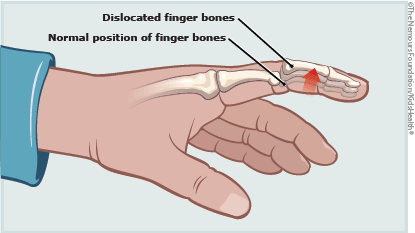- Parents Home
- Para Padres
- A to Z Dictionary
- Allergy Center
- Asthma
- Cancer
- Diabetes
- Diseases & Conditions
- Doctors & Hospitals
- Emotions & Behavior
- First Aid & Safety
- Flu (Influenza)
- Food Allergies
- General Health
- Growth & Development
- Heart Health & Conditions
- Homework Help Center
- Infections
- Newborn Care
- Nutrition & Fitness
- Play & Learn
- Pregnancy Center
- Preventing Premature Birth
- Q&A
- School & Family Life
- Sports Medicine
- Teens Home
- Para Adolescentes
- Asthma
- Be Your Best Self
- Body & Skin Care
- Cancer
- Diabetes
- Diseases & Conditions
- Drugs & Alcohol
- Flu (Influenza)
- Homework Help
- Infections
- Managing Your Weight
- Medical Care 101
- Mental Health
- Nutrition & Fitness
- Q&A
- Safety & First Aid
- School, Jobs, & Friends
- Sexual Health
- Sports Medicine
- Stress & Coping
A to Z: Dislocation, Finger
A dislocation is when the bones in a joint slip out of their normal position. A finger dislocation may happen from a fall, blow, or sports injury, especially if the finger is bent back or jammed.

More to Know
A dislocated finger is usually diagnosed through an X-ray. The bones may move back into place on their own or a doctor might gently put the joint back with a quick maneuver called a reduction. In some cases, surgery is needed to repair the joint
To keep the joint from dislocating again, a splint is put on the injured finger or the injured finger is taped to the neighboring finger ("buddy taping"). Depending on the injury, the splint or buddy taping will remain for a few days to a few weeks. Gentle hand exercises might be recommended to help strengthen the finger and reduce joint stiffness.
Keep in Mind
With proper treatment, most people who dislocate a finger can gradually return to their normal activities. The finger may feel sore or stiff for a while.
All A to Z dictionary entries are regularly reviewed by KidsHealth medical experts.
- Preventing Children's Sports Injuries
- Nursemaid's Elbow
- Preventing Injuries From Falling, Climbing, and Grabbing
- What to Do About a Dislocation
- Kids & Sports (Topic Center)
- X-Ray Exam: Finger
- A to Z: Slipped Capital Femoral Epiphysis (SCFE)
- A to Z: Contusion (Bruise), Finger
- A to Z: Radial Head Subluxation
- Bones, Muscles, and Joints

© 1995- The Nemours Foundation. KidsHealth® is a registered trademark of The Nemours Foundation. All rights reserved.
Images sourced by The Nemours Foundation and Getty Images.
